Contemporary Economics Analysis: Tesco, Demand, Supply, and Theories
VerifiedAdded on 2023/01/11
|12
|3132
|72
Report
AI Summary
This report provides a contemporary economics analysis, focusing on the law of demand and supply, and how they relate to business practices. The report begins with an introduction to contemporary economics and selects Tesco Plc as a case study. It delves into the law of demand, explaining its principles, factors affecting the demand curve, and shifts in the curve, supported by graphical representations. The report then explores the law of supply, outlining its principles, factors affecting the supply curve, and shifts in the curve. The second task compares and contrasts 20th and 21st-century economic theories, specifically the neoclassical theory and the Nudge theory, and relates these theories to modern business practices. The report concludes by summarizing the key findings and insights gained from the analysis. The report aims to provide a comprehensive understanding of the economic principles and their practical implications in the business world.
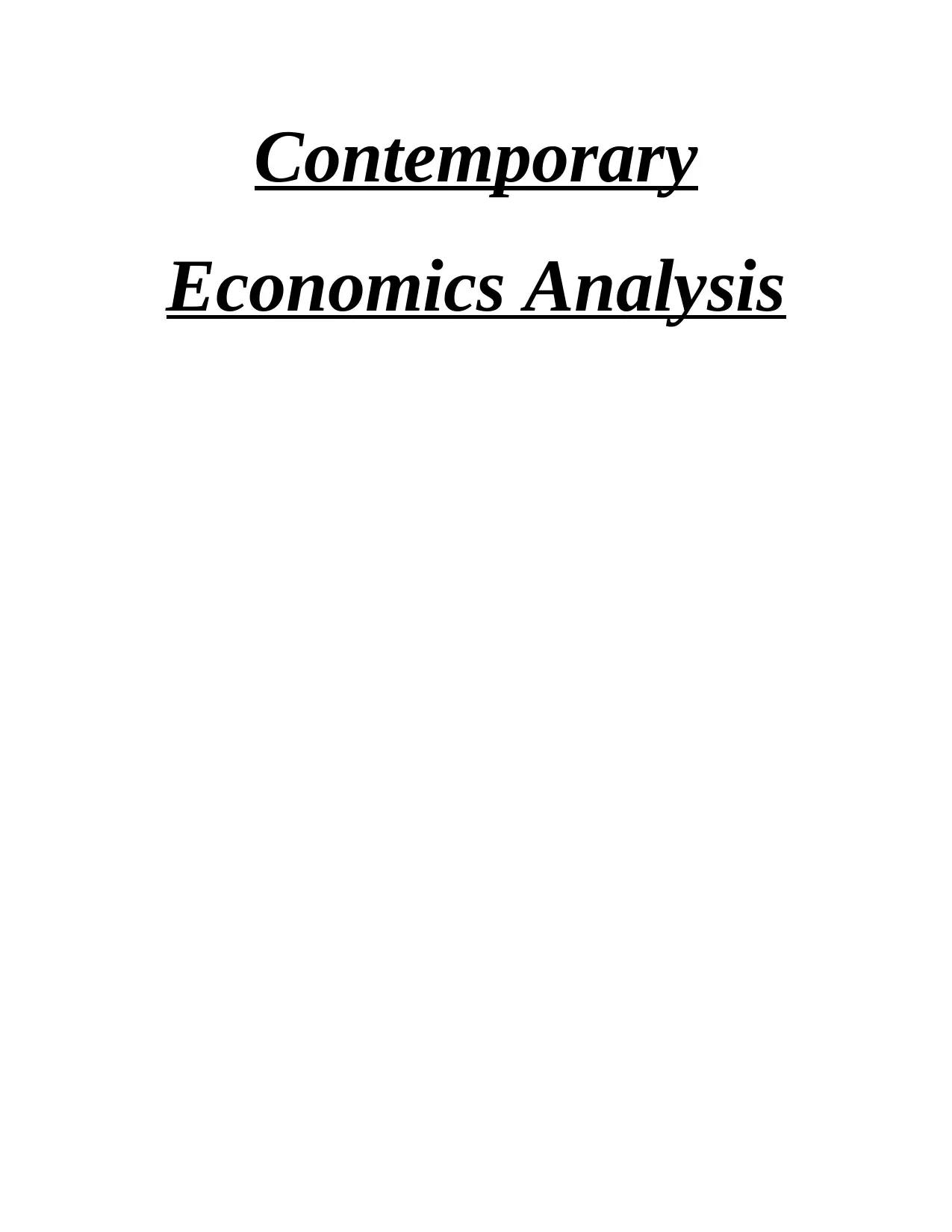
Contemporary
Economics Analysis
Economics Analysis
Paraphrase This Document
Need a fresh take? Get an instant paraphrase of this document with our AI Paraphraser
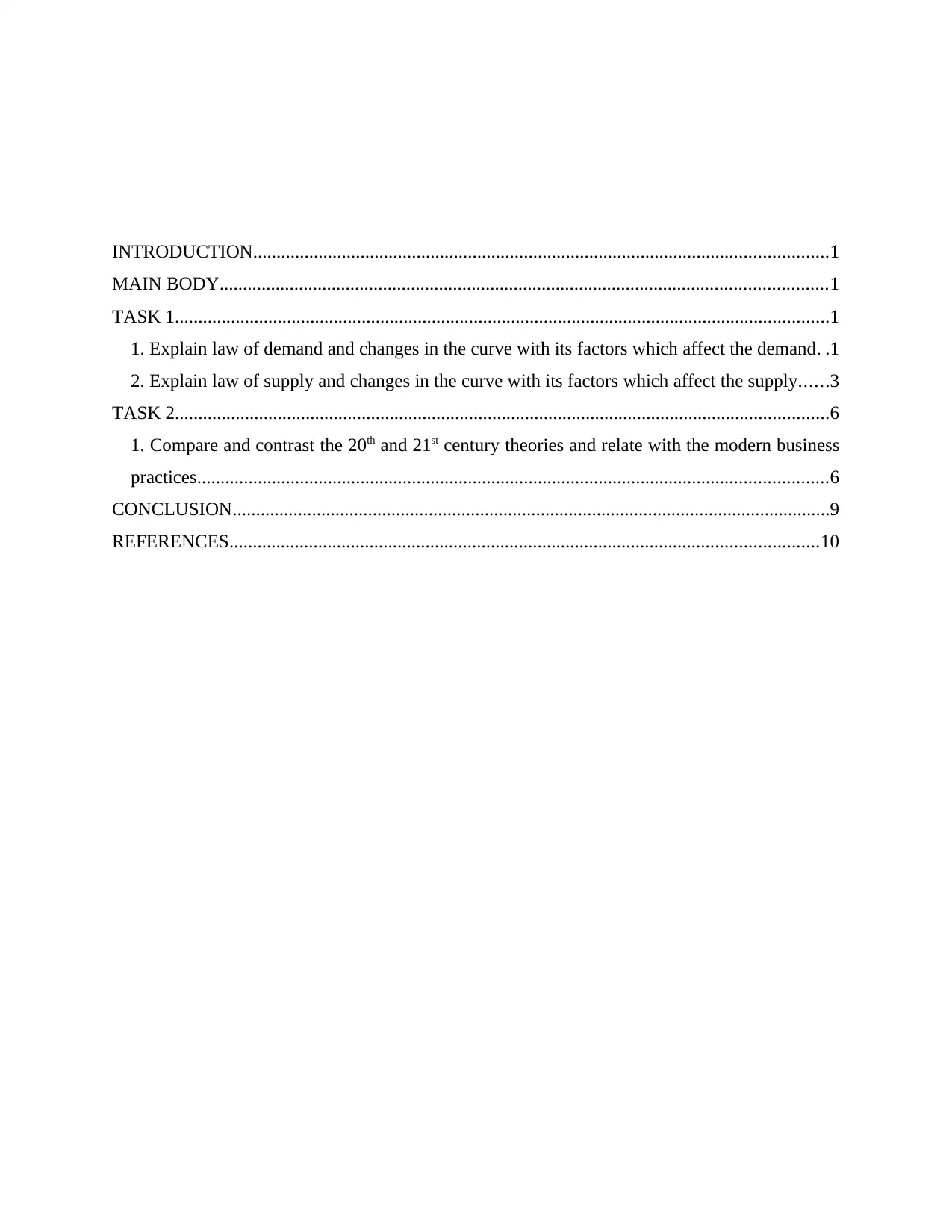
INTRODUCTION...........................................................................................................................1
MAIN BODY..................................................................................................................................1
TASK 1............................................................................................................................................1
1. Explain law of demand and changes in the curve with its factors which affect the demand. .1
2. Explain law of supply and changes in the curve with its factors which affect the supply......3
TASK 2............................................................................................................................................6
1. Compare and contrast the 20th and 21st century theories and relate with the modern business
practices.......................................................................................................................................6
CONCLUSION................................................................................................................................9
REFERENCES..............................................................................................................................10
MAIN BODY..................................................................................................................................1
TASK 1............................................................................................................................................1
1. Explain law of demand and changes in the curve with its factors which affect the demand. .1
2. Explain law of supply and changes in the curve with its factors which affect the supply......3
TASK 2............................................................................................................................................6
1. Compare and contrast the 20th and 21st century theories and relate with the modern business
practices.......................................................................................................................................6
CONCLUSION................................................................................................................................9
REFERENCES..............................................................................................................................10
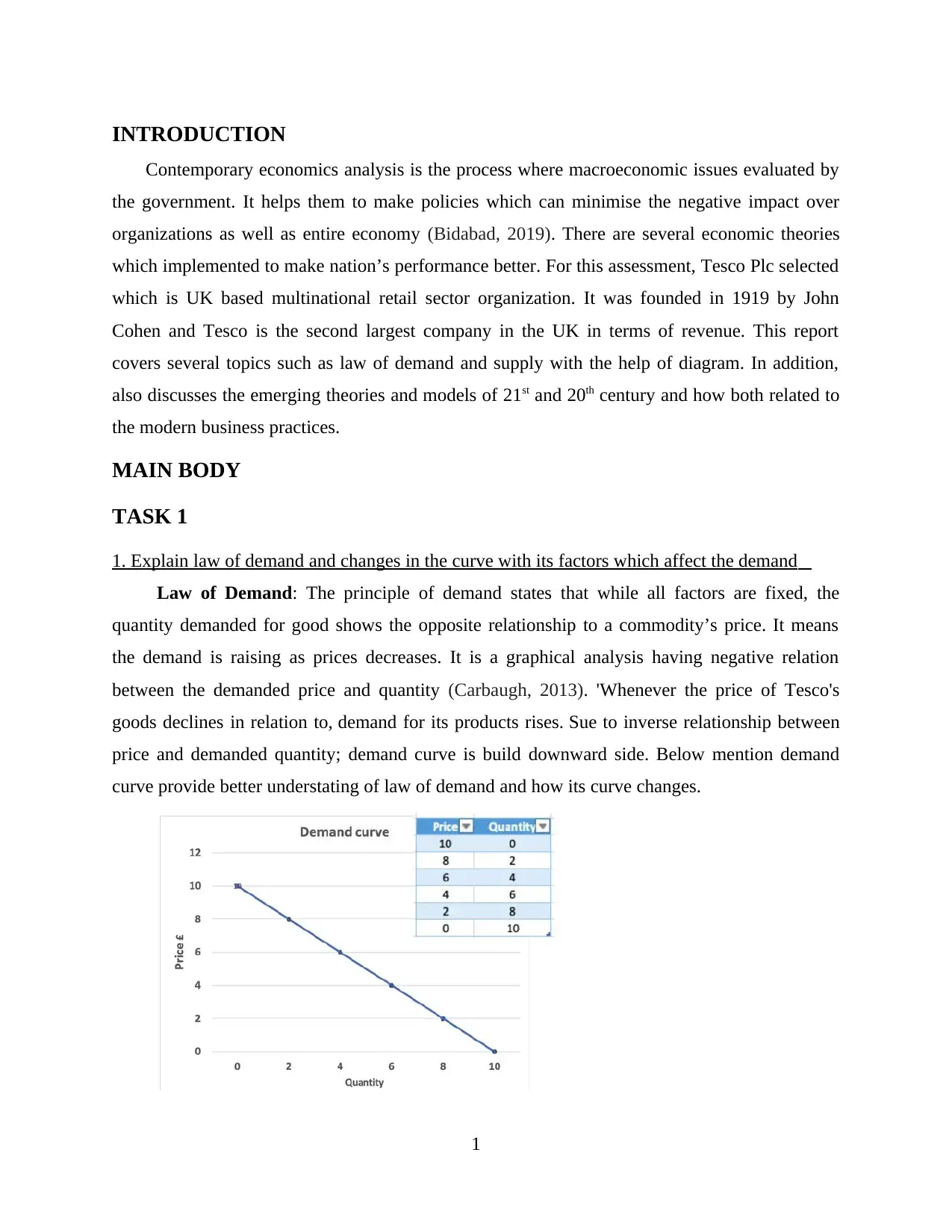
INTRODUCTION
Contemporary economics analysis is the process where macroeconomic issues evaluated by
the government. It helps them to make policies which can minimise the negative impact over
organizations as well as entire economy (Bidabad, 2019). There are several economic theories
which implemented to make nation’s performance better. For this assessment, Tesco Plc selected
which is UK based multinational retail sector organization. It was founded in 1919 by John
Cohen and Tesco is the second largest company in the UK in terms of revenue. This report
covers several topics such as law of demand and supply with the help of diagram. In addition,
also discusses the emerging theories and models of 21st and 20th century and how both related to
the modern business practices.
MAIN BODY
TASK 1
1. Explain law of demand and changes in the curve with its factors which affect the demand
Law of Demand: The principle of demand states that while all factors are fixed, the
quantity demanded for good shows the opposite relationship to a commodity’s price. It means
the demand is raising as prices decreases. It is a graphical analysis having negative relation
between the demanded price and quantity (Carbaugh, 2013). 'Whenever the price of Tesco's
goods declines in relation to, demand for its products rises. Sue to inverse relationship between
price and demanded quantity; demand curve is build downward side. Below mention demand
curve provide better understating of law of demand and how its curve changes.
1
Contemporary economics analysis is the process where macroeconomic issues evaluated by
the government. It helps them to make policies which can minimise the negative impact over
organizations as well as entire economy (Bidabad, 2019). There are several economic theories
which implemented to make nation’s performance better. For this assessment, Tesco Plc selected
which is UK based multinational retail sector organization. It was founded in 1919 by John
Cohen and Tesco is the second largest company in the UK in terms of revenue. This report
covers several topics such as law of demand and supply with the help of diagram. In addition,
also discusses the emerging theories and models of 21st and 20th century and how both related to
the modern business practices.
MAIN BODY
TASK 1
1. Explain law of demand and changes in the curve with its factors which affect the demand
Law of Demand: The principle of demand states that while all factors are fixed, the
quantity demanded for good shows the opposite relationship to a commodity’s price. It means
the demand is raising as prices decreases. It is a graphical analysis having negative relation
between the demanded price and quantity (Carbaugh, 2013). 'Whenever the price of Tesco's
goods declines in relation to, demand for its products rises. Sue to inverse relationship between
price and demanded quantity; demand curve is build downward side. Below mention demand
curve provide better understating of law of demand and how its curve changes.
1
⊘ This is a preview!⊘
Do you want full access?
Subscribe today to unlock all pages.

Trusted by 1+ million students worldwide
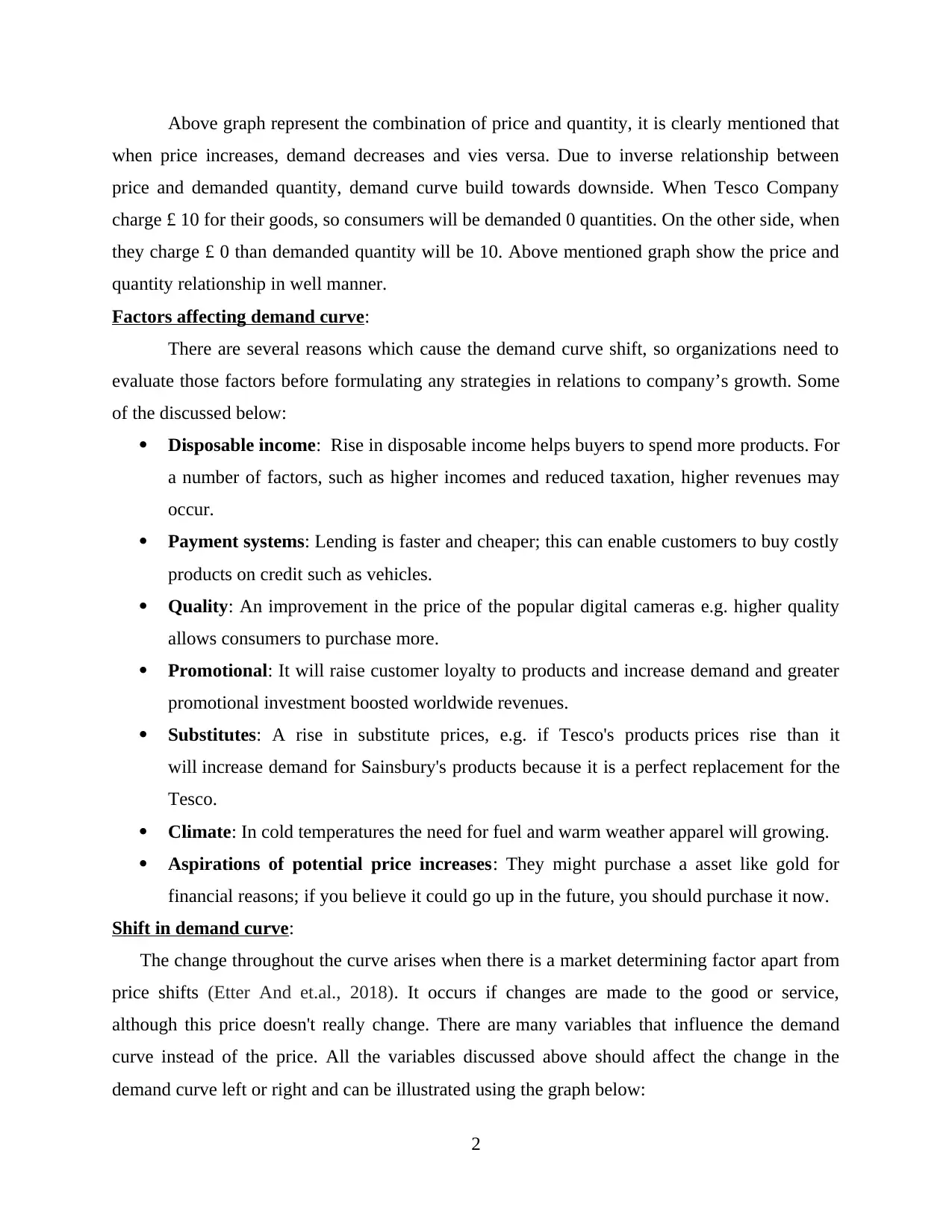
Above graph represent the combination of price and quantity, it is clearly mentioned that
when price increases, demand decreases and vies versa. Due to inverse relationship between
price and demanded quantity, demand curve build towards downside. When Tesco Company
charge £ 10 for their goods, so consumers will be demanded 0 quantities. On the other side, when
they charge £ 0 than demanded quantity will be 10. Above mentioned graph show the price and
quantity relationship in well manner.
Factors affecting demand curve:
There are several reasons which cause the demand curve shift, so organizations need to
evaluate those factors before formulating any strategies in relations to company’s growth. Some
of the discussed below:
Disposable income: Rise in disposable income helps buyers to spend more products. For
a number of factors, such as higher incomes and reduced taxation, higher revenues may
occur.
Payment systems: Lending is faster and cheaper; this can enable customers to buy costly
products on credit such as vehicles.
Quality: An improvement in the price of the popular digital cameras e.g. higher quality
allows consumers to purchase more.
Promotional: It will raise customer loyalty to products and increase demand and greater
promotional investment boosted worldwide revenues.
Substitutes: A rise in substitute prices, e.g. if Tesco's products prices rise than it
will increase demand for Sainsbury's products because it is a perfect replacement for the
Tesco.
Climate: In cold temperatures the need for fuel and warm weather apparel will growing.
Aspirations of potential price increases: They might purchase a asset like gold for
financial reasons; if you believe it could go up in the future, you should purchase it now.
Shift in demand curve:
The change throughout the curve arises when there is a market determining factor apart from
price shifts (Etter And et.al., 2018). It occurs if changes are made to the good or service,
although this price doesn't really change. There are many variables that influence the demand
curve instead of the price. All the variables discussed above should affect the change in the
demand curve left or right and can be illustrated using the graph below:
2
when price increases, demand decreases and vies versa. Due to inverse relationship between
price and demanded quantity, demand curve build towards downside. When Tesco Company
charge £ 10 for their goods, so consumers will be demanded 0 quantities. On the other side, when
they charge £ 0 than demanded quantity will be 10. Above mentioned graph show the price and
quantity relationship in well manner.
Factors affecting demand curve:
There are several reasons which cause the demand curve shift, so organizations need to
evaluate those factors before formulating any strategies in relations to company’s growth. Some
of the discussed below:
Disposable income: Rise in disposable income helps buyers to spend more products. For
a number of factors, such as higher incomes and reduced taxation, higher revenues may
occur.
Payment systems: Lending is faster and cheaper; this can enable customers to buy costly
products on credit such as vehicles.
Quality: An improvement in the price of the popular digital cameras e.g. higher quality
allows consumers to purchase more.
Promotional: It will raise customer loyalty to products and increase demand and greater
promotional investment boosted worldwide revenues.
Substitutes: A rise in substitute prices, e.g. if Tesco's products prices rise than it
will increase demand for Sainsbury's products because it is a perfect replacement for the
Tesco.
Climate: In cold temperatures the need for fuel and warm weather apparel will growing.
Aspirations of potential price increases: They might purchase a asset like gold for
financial reasons; if you believe it could go up in the future, you should purchase it now.
Shift in demand curve:
The change throughout the curve arises when there is a market determining factor apart from
price shifts (Etter And et.al., 2018). It occurs if changes are made to the good or service,
although this price doesn't really change. There are many variables that influence the demand
curve instead of the price. All the variables discussed above should affect the change in the
demand curve left or right and can be illustrated using the graph below:
2
Paraphrase This Document
Need a fresh take? Get an instant paraphrase of this document with our AI Paraphraser
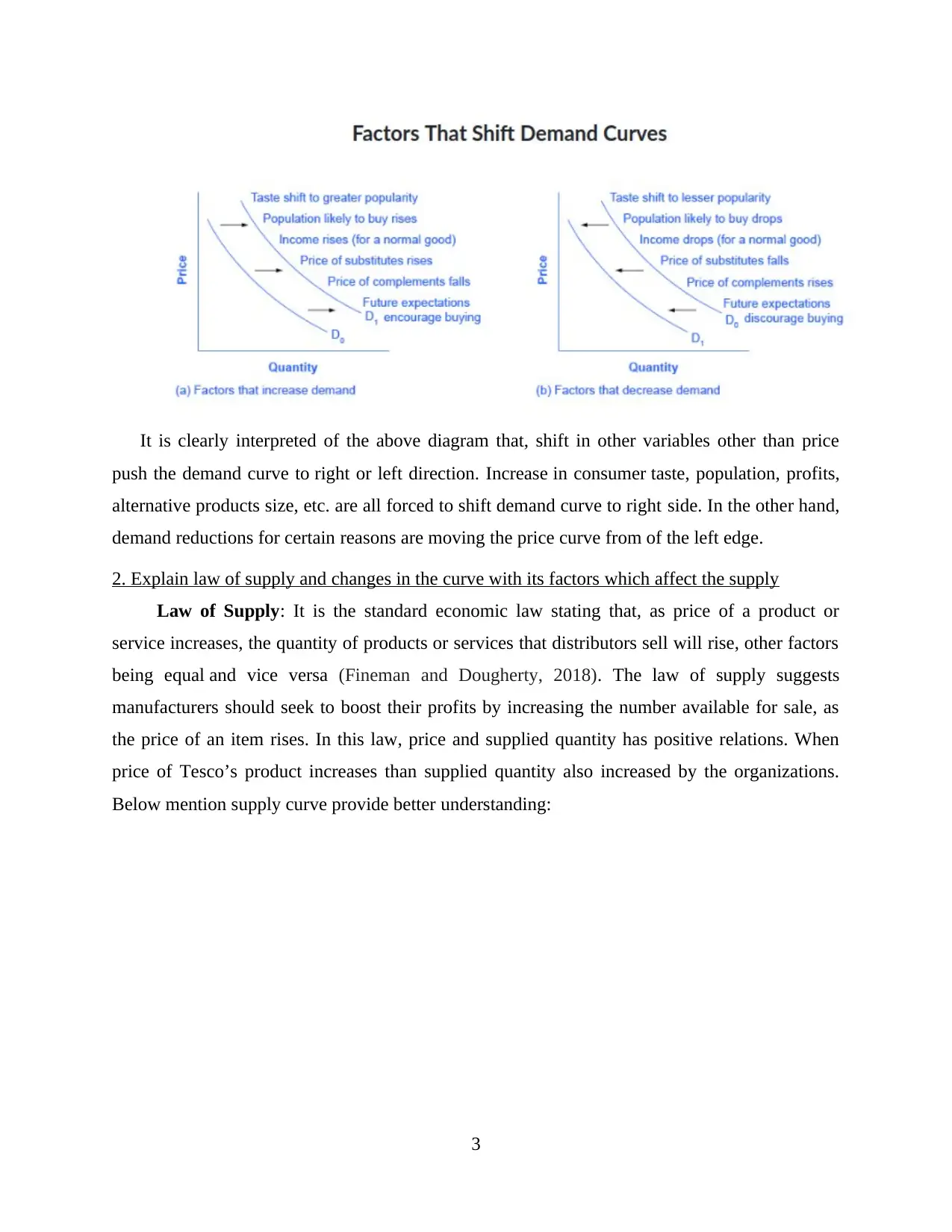
It is clearly interpreted of the above diagram that, shift in other variables other than price
push the demand curve to right or left direction. Increase in consumer taste, population, profits,
alternative products size, etc. are all forced to shift demand curve to right side. In the other hand,
demand reductions for certain reasons are moving the price curve from of the left edge.
2. Explain law of supply and changes in the curve with its factors which affect the supply
Law of Supply: It is the standard economic law stating that, as price of a product or
service increases, the quantity of products or services that distributors sell will rise, other factors
being equal and vice versa (Fineman and Dougherty, 2018). The law of supply suggests
manufacturers should seek to boost their profits by increasing the number available for sale, as
the price of an item rises. In this law, price and supplied quantity has positive relations. When
price of Tesco’s product increases than supplied quantity also increased by the organizations.
Below mention supply curve provide better understanding:
3
push the demand curve to right or left direction. Increase in consumer taste, population, profits,
alternative products size, etc. are all forced to shift demand curve to right side. In the other hand,
demand reductions for certain reasons are moving the price curve from of the left edge.
2. Explain law of supply and changes in the curve with its factors which affect the supply
Law of Supply: It is the standard economic law stating that, as price of a product or
service increases, the quantity of products or services that distributors sell will rise, other factors
being equal and vice versa (Fineman and Dougherty, 2018). The law of supply suggests
manufacturers should seek to boost their profits by increasing the number available for sale, as
the price of an item rises. In this law, price and supplied quantity has positive relations. When
price of Tesco’s product increases than supplied quantity also increased by the organizations.
Below mention supply curve provide better understanding:
3
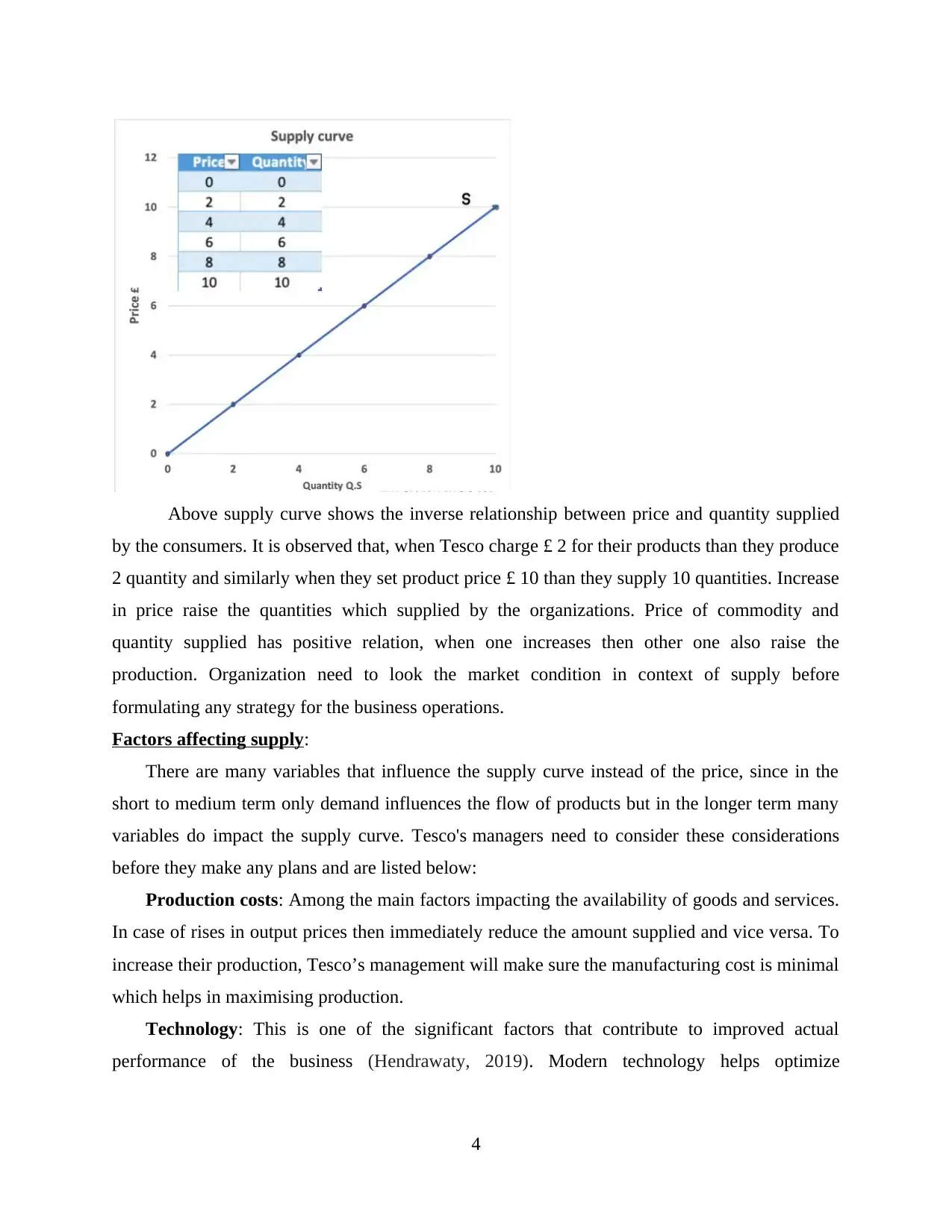
Above supply curve shows the inverse relationship between price and quantity supplied
by the consumers. It is observed that, when Tesco charge £ 2 for their products than they produce
2 quantity and similarly when they set product price £ 10 than they supply 10 quantities. Increase
in price raise the quantities which supplied by the organizations. Price of commodity and
quantity supplied has positive relation, when one increases then other one also raise the
production. Organization need to look the market condition in context of supply before
formulating any strategy for the business operations.
Factors affecting supply:
There are many variables that influence the supply curve instead of the price, since in the
short to medium term only demand influences the flow of products but in the longer term many
variables do impact the supply curve. Tesco's managers need to consider these considerations
before they make any plans and are listed below:
Production costs: Among the main factors impacting the availability of goods and services.
In case of rises in output prices then immediately reduce the amount supplied and vice versa. To
increase their production, Tesco’s management will make sure the manufacturing cost is minimal
which helps in maximising production.
Technology: This is one of the significant factors that contribute to improved actual
performance of the business (Hendrawaty, 2019). Modern technology helps optimize
4
by the consumers. It is observed that, when Tesco charge £ 2 for their products than they produce
2 quantity and similarly when they set product price £ 10 than they supply 10 quantities. Increase
in price raise the quantities which supplied by the organizations. Price of commodity and
quantity supplied has positive relation, when one increases then other one also raise the
production. Organization need to look the market condition in context of supply before
formulating any strategy for the business operations.
Factors affecting supply:
There are many variables that influence the supply curve instead of the price, since in the
short to medium term only demand influences the flow of products but in the longer term many
variables do impact the supply curve. Tesco's managers need to consider these considerations
before they make any plans and are listed below:
Production costs: Among the main factors impacting the availability of goods and services.
In case of rises in output prices then immediately reduce the amount supplied and vice versa. To
increase their production, Tesco’s management will make sure the manufacturing cost is minimal
which helps in maximising production.
Technology: This is one of the significant factors that contribute to improved actual
performance of the business (Hendrawaty, 2019). Modern technology helps optimize
4
⊘ This is a preview!⊘
Do you want full access?
Subscribe today to unlock all pages.

Trusted by 1+ million students worldwide
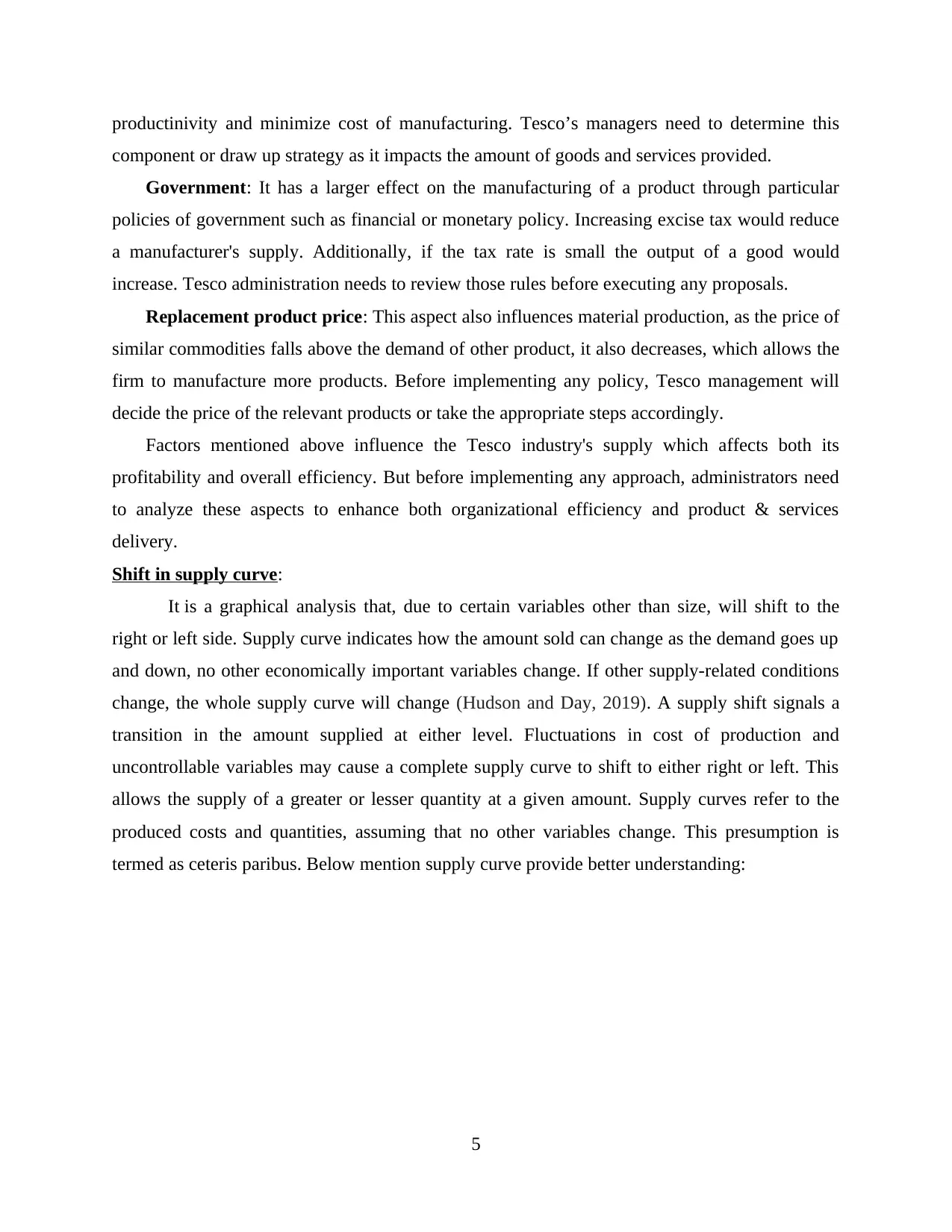
productinivity and minimize cost of manufacturing. Tesco’s managers need to determine this
component or draw up strategy as it impacts the amount of goods and services provided.
Government: It has a larger effect on the manufacturing of a product through particular
policies of government such as financial or monetary policy. Increasing excise tax would reduce
a manufacturer's supply. Additionally, if the tax rate is small the output of a good would
increase. Tesco administration needs to review those rules before executing any proposals.
Replacement product price: This aspect also influences material production, as the price of
similar commodities falls above the demand of other product, it also decreases, which allows the
firm to manufacture more products. Before implementing any policy, Tesco management will
decide the price of the relevant products or take the appropriate steps accordingly.
Factors mentioned above influence the Tesco industry's supply which affects both its
profitability and overall efficiency. But before implementing any approach, administrators need
to analyze these aspects to enhance both organizational efficiency and product & services
delivery.
Shift in supply curve:
It is a graphical analysis that, due to certain variables other than size, will shift to the
right or left side. Supply curve indicates how the amount sold can change as the demand goes up
and down, no other economically important variables change. If other supply-related conditions
change, the whole supply curve will change (Hudson and Day, 2019). A supply shift signals a
transition in the amount supplied at either level. Fluctuations in cost of production and
uncontrollable variables may cause a complete supply curve to shift to either right or left. This
allows the supply of a greater or lesser quantity at a given amount. Supply curves refer to the
produced costs and quantities, assuming that no other variables change. This presumption is
termed as ceteris paribus. Below mention supply curve provide better understanding:
5
component or draw up strategy as it impacts the amount of goods and services provided.
Government: It has a larger effect on the manufacturing of a product through particular
policies of government such as financial or monetary policy. Increasing excise tax would reduce
a manufacturer's supply. Additionally, if the tax rate is small the output of a good would
increase. Tesco administration needs to review those rules before executing any proposals.
Replacement product price: This aspect also influences material production, as the price of
similar commodities falls above the demand of other product, it also decreases, which allows the
firm to manufacture more products. Before implementing any policy, Tesco management will
decide the price of the relevant products or take the appropriate steps accordingly.
Factors mentioned above influence the Tesco industry's supply which affects both its
profitability and overall efficiency. But before implementing any approach, administrators need
to analyze these aspects to enhance both organizational efficiency and product & services
delivery.
Shift in supply curve:
It is a graphical analysis that, due to certain variables other than size, will shift to the
right or left side. Supply curve indicates how the amount sold can change as the demand goes up
and down, no other economically important variables change. If other supply-related conditions
change, the whole supply curve will change (Hudson and Day, 2019). A supply shift signals a
transition in the amount supplied at either level. Fluctuations in cost of production and
uncontrollable variables may cause a complete supply curve to shift to either right or left. This
allows the supply of a greater or lesser quantity at a given amount. Supply curves refer to the
produced costs and quantities, assuming that no other variables change. This presumption is
termed as ceteris paribus. Below mention supply curve provide better understanding:
5
Paraphrase This Document
Need a fresh take? Get an instant paraphrase of this document with our AI Paraphraser
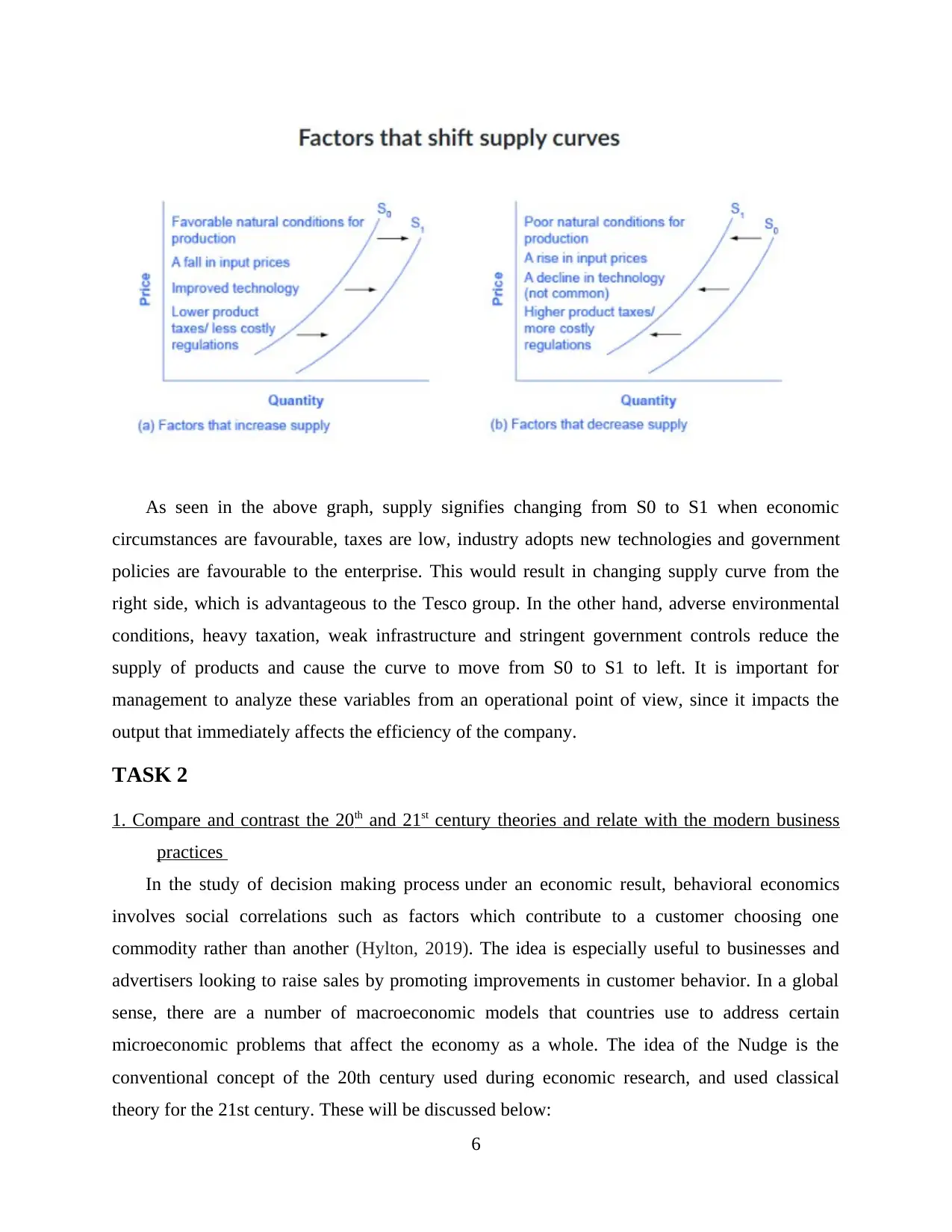
As seen in the above graph, supply signifies changing from S0 to S1 when economic
circumstances are favourable, taxes are low, industry adopts new technologies and government
policies are favourable to the enterprise. This would result in changing supply curve from the
right side, which is advantageous to the Tesco group. In the other hand, adverse environmental
conditions, heavy taxation, weak infrastructure and stringent government controls reduce the
supply of products and cause the curve to move from S0 to S1 to left. It is important for
management to analyze these variables from an operational point of view, since it impacts the
output that immediately affects the efficiency of the company.
TASK 2
1. Compare and contrast the 20th and 21st century theories and relate with the modern business
practices
In the study of decision making process under an economic result, behavioral economics
involves social correlations such as factors which contribute to a customer choosing one
commodity rather than another (Hylton, 2019). The idea is especially useful to businesses and
advertisers looking to raise sales by promoting improvements in customer behavior. In a global
sense, there are a number of macroeconomic models that countries use to address certain
microeconomic problems that affect the economy as a whole. The idea of the Nudge is the
conventional concept of the 20th century used during economic research, and used classical
theory for the 21st century. These will be discussed below:
6
circumstances are favourable, taxes are low, industry adopts new technologies and government
policies are favourable to the enterprise. This would result in changing supply curve from the
right side, which is advantageous to the Tesco group. In the other hand, adverse environmental
conditions, heavy taxation, weak infrastructure and stringent government controls reduce the
supply of products and cause the curve to move from S0 to S1 to left. It is important for
management to analyze these variables from an operational point of view, since it impacts the
output that immediately affects the efficiency of the company.
TASK 2
1. Compare and contrast the 20th and 21st century theories and relate with the modern business
practices
In the study of decision making process under an economic result, behavioral economics
involves social correlations such as factors which contribute to a customer choosing one
commodity rather than another (Hylton, 2019). The idea is especially useful to businesses and
advertisers looking to raise sales by promoting improvements in customer behavior. In a global
sense, there are a number of macroeconomic models that countries use to address certain
microeconomic problems that affect the economy as a whole. The idea of the Nudge is the
conventional concept of the 20th century used during economic research, and used classical
theory for the 21st century. These will be discussed below:
6
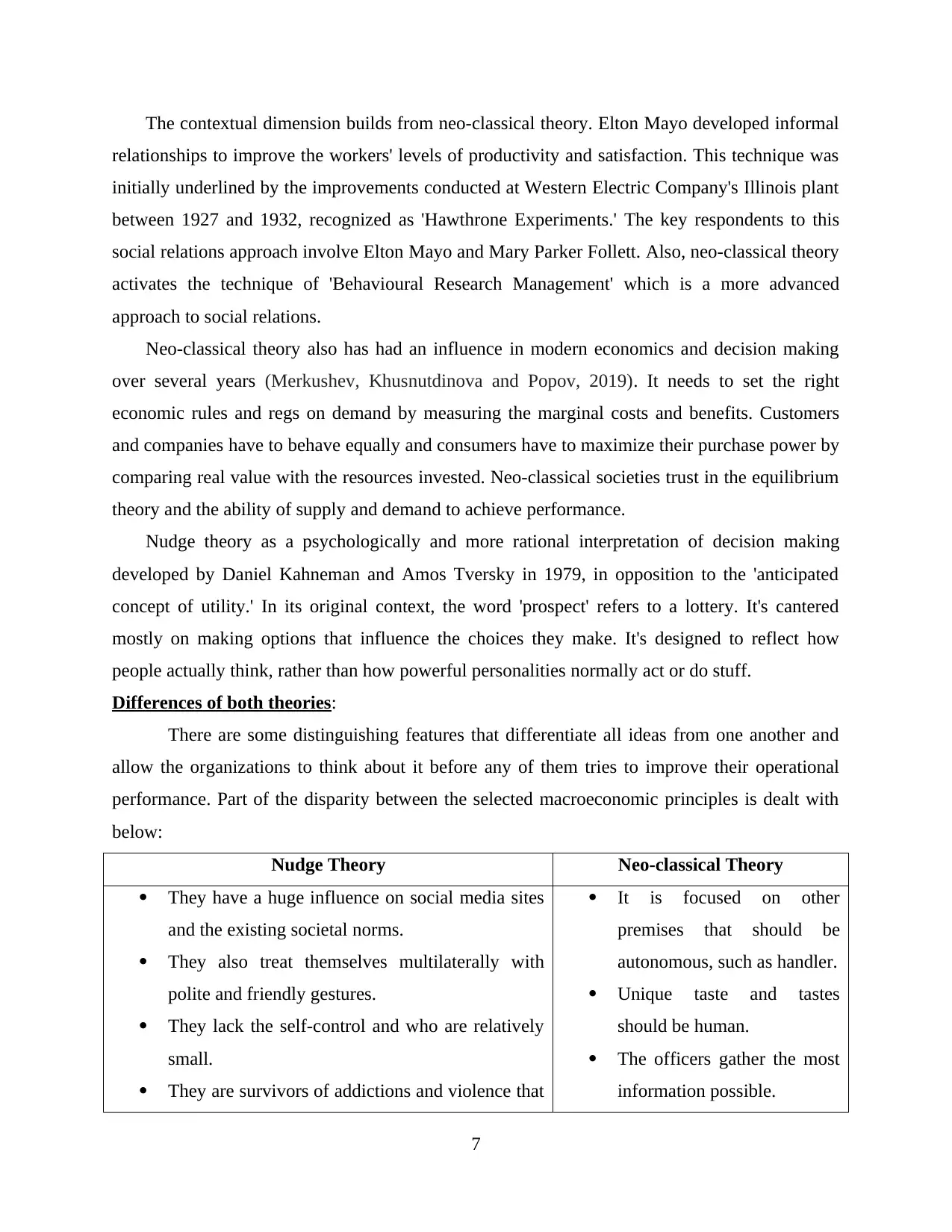
The contextual dimension builds from neo-classical theory. Elton Mayo developed informal
relationships to improve the workers' levels of productivity and satisfaction. This technique was
initially underlined by the improvements conducted at Western Electric Company's Illinois plant
between 1927 and 1932, recognized as 'Hawthrone Experiments.' The key respondents to this
social relations approach involve Elton Mayo and Mary Parker Follett. Also, neo-classical theory
activates the technique of 'Behavioural Research Management' which is a more advanced
approach to social relations.
Neo-classical theory also has had an influence in modern economics and decision making
over several years (Merkushev, Khusnutdinova and Popov, 2019). It needs to set the right
economic rules and regs on demand by measuring the marginal costs and benefits. Customers
and companies have to behave equally and consumers have to maximize their purchase power by
comparing real value with the resources invested. Neo-classical societies trust in the equilibrium
theory and the ability of supply and demand to achieve performance.
Nudge theory as a psychologically and more rational interpretation of decision making
developed by Daniel Kahneman and Amos Tversky in 1979, in opposition to the 'anticipated
concept of utility.' In its original context, the word 'prospect' refers to a lottery. It's cantered
mostly on making options that influence the choices they make. It's designed to reflect how
people actually think, rather than how powerful personalities normally act or do stuff.
Differences of both theories:
There are some distinguishing features that differentiate all ideas from one another and
allow the organizations to think about it before any of them tries to improve their operational
performance. Part of the disparity between the selected macroeconomic principles is dealt with
below:
Nudge Theory Neo-classical Theory
They have a huge influence on social media sites
and the existing societal norms.
They also treat themselves multilaterally with
polite and friendly gestures.
They lack the self-control and who are relatively
small.
They are survivors of addictions and violence that
It is focused on other
premises that should be
autonomous, such as handler.
Unique taste and tastes
should be human.
The officers gather the most
information possible.
7
relationships to improve the workers' levels of productivity and satisfaction. This technique was
initially underlined by the improvements conducted at Western Electric Company's Illinois plant
between 1927 and 1932, recognized as 'Hawthrone Experiments.' The key respondents to this
social relations approach involve Elton Mayo and Mary Parker Follett. Also, neo-classical theory
activates the technique of 'Behavioural Research Management' which is a more advanced
approach to social relations.
Neo-classical theory also has had an influence in modern economics and decision making
over several years (Merkushev, Khusnutdinova and Popov, 2019). It needs to set the right
economic rules and regs on demand by measuring the marginal costs and benefits. Customers
and companies have to behave equally and consumers have to maximize their purchase power by
comparing real value with the resources invested. Neo-classical societies trust in the equilibrium
theory and the ability of supply and demand to achieve performance.
Nudge theory as a psychologically and more rational interpretation of decision making
developed by Daniel Kahneman and Amos Tversky in 1979, in opposition to the 'anticipated
concept of utility.' In its original context, the word 'prospect' refers to a lottery. It's cantered
mostly on making options that influence the choices they make. It's designed to reflect how
people actually think, rather than how powerful personalities normally act or do stuff.
Differences of both theories:
There are some distinguishing features that differentiate all ideas from one another and
allow the organizations to think about it before any of them tries to improve their operational
performance. Part of the disparity between the selected macroeconomic principles is dealt with
below:
Nudge Theory Neo-classical Theory
They have a huge influence on social media sites
and the existing societal norms.
They also treat themselves multilaterally with
polite and friendly gestures.
They lack the self-control and who are relatively
small.
They are survivors of addictions and violence that
It is focused on other
premises that should be
autonomous, such as handler.
Unique taste and tastes
should be human.
The officers gather the most
information possible.
7
⊘ This is a preview!⊘
Do you want full access?
Subscribe today to unlock all pages.

Trusted by 1+ million students worldwide
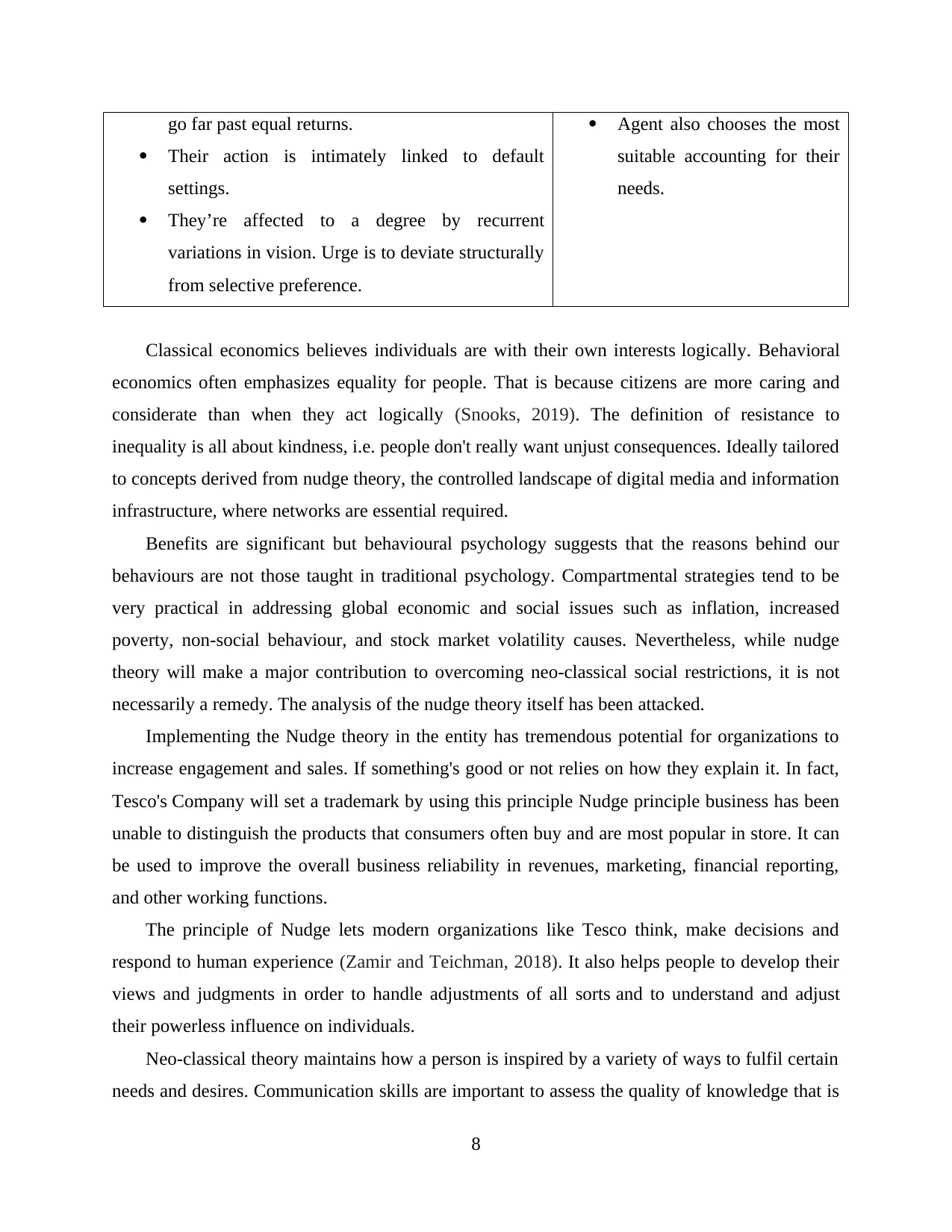
go far past equal returns.
Their action is intimately linked to default
settings.
They’re affected to a degree by recurrent
variations in vision. Urge is to deviate structurally
from selective preference.
Agent also chooses the most
suitable accounting for their
needs.
Classical economics believes individuals are with their own interests logically. Behavioral
economics often emphasizes equality for people. That is because citizens are more caring and
considerate than when they act logically (Snooks, 2019). The definition of resistance to
inequality is all about kindness, i.e. people don't really want unjust consequences. Ideally tailored
to concepts derived from nudge theory, the controlled landscape of digital media and information
infrastructure, where networks are essential required.
Benefits are significant but behavioural psychology suggests that the reasons behind our
behaviours are not those taught in traditional psychology. Compartmental strategies tend to be
very practical in addressing global economic and social issues such as inflation, increased
poverty, non-social behaviour, and stock market volatility causes. Nevertheless, while nudge
theory will make a major contribution to overcoming neo-classical social restrictions, it is not
necessarily a remedy. The analysis of the nudge theory itself has been attacked.
Implementing the Nudge theory in the entity has tremendous potential for organizations to
increase engagement and sales. If something's good or not relies on how they explain it. In fact,
Tesco's Company will set a trademark by using this principle Nudge principle business has been
unable to distinguish the products that consumers often buy and are most popular in store. It can
be used to improve the overall business reliability in revenues, marketing, financial reporting,
and other working functions.
The principle of Nudge lets modern organizations like Tesco think, make decisions and
respond to human experience (Zamir and Teichman, 2018). It also helps people to develop their
views and judgments in order to handle adjustments of all sorts and to understand and adjust
their powerless influence on individuals.
Neo-classical theory maintains how a person is inspired by a variety of ways to fulfil certain
needs and desires. Communication skills are important to assess the quality of knowledge that is
8
Their action is intimately linked to default
settings.
They’re affected to a degree by recurrent
variations in vision. Urge is to deviate structurally
from selective preference.
Agent also chooses the most
suitable accounting for their
needs.
Classical economics believes individuals are with their own interests logically. Behavioral
economics often emphasizes equality for people. That is because citizens are more caring and
considerate than when they act logically (Snooks, 2019). The definition of resistance to
inequality is all about kindness, i.e. people don't really want unjust consequences. Ideally tailored
to concepts derived from nudge theory, the controlled landscape of digital media and information
infrastructure, where networks are essential required.
Benefits are significant but behavioural psychology suggests that the reasons behind our
behaviours are not those taught in traditional psychology. Compartmental strategies tend to be
very practical in addressing global economic and social issues such as inflation, increased
poverty, non-social behaviour, and stock market volatility causes. Nevertheless, while nudge
theory will make a major contribution to overcoming neo-classical social restrictions, it is not
necessarily a remedy. The analysis of the nudge theory itself has been attacked.
Implementing the Nudge theory in the entity has tremendous potential for organizations to
increase engagement and sales. If something's good or not relies on how they explain it. In fact,
Tesco's Company will set a trademark by using this principle Nudge principle business has been
unable to distinguish the products that consumers often buy and are most popular in store. It can
be used to improve the overall business reliability in revenues, marketing, financial reporting,
and other working functions.
The principle of Nudge lets modern organizations like Tesco think, make decisions and
respond to human experience (Zamir and Teichman, 2018). It also helps people to develop their
views and judgments in order to handle adjustments of all sorts and to understand and adjust
their powerless influence on individuals.
Neo-classical theory maintains how a person is inspired by a variety of ways to fulfil certain
needs and desires. Communication skills are important to assess the quality of knowledge that is
8
Paraphrase This Document
Need a fresh take? Get an instant paraphrase of this document with our AI Paraphraser
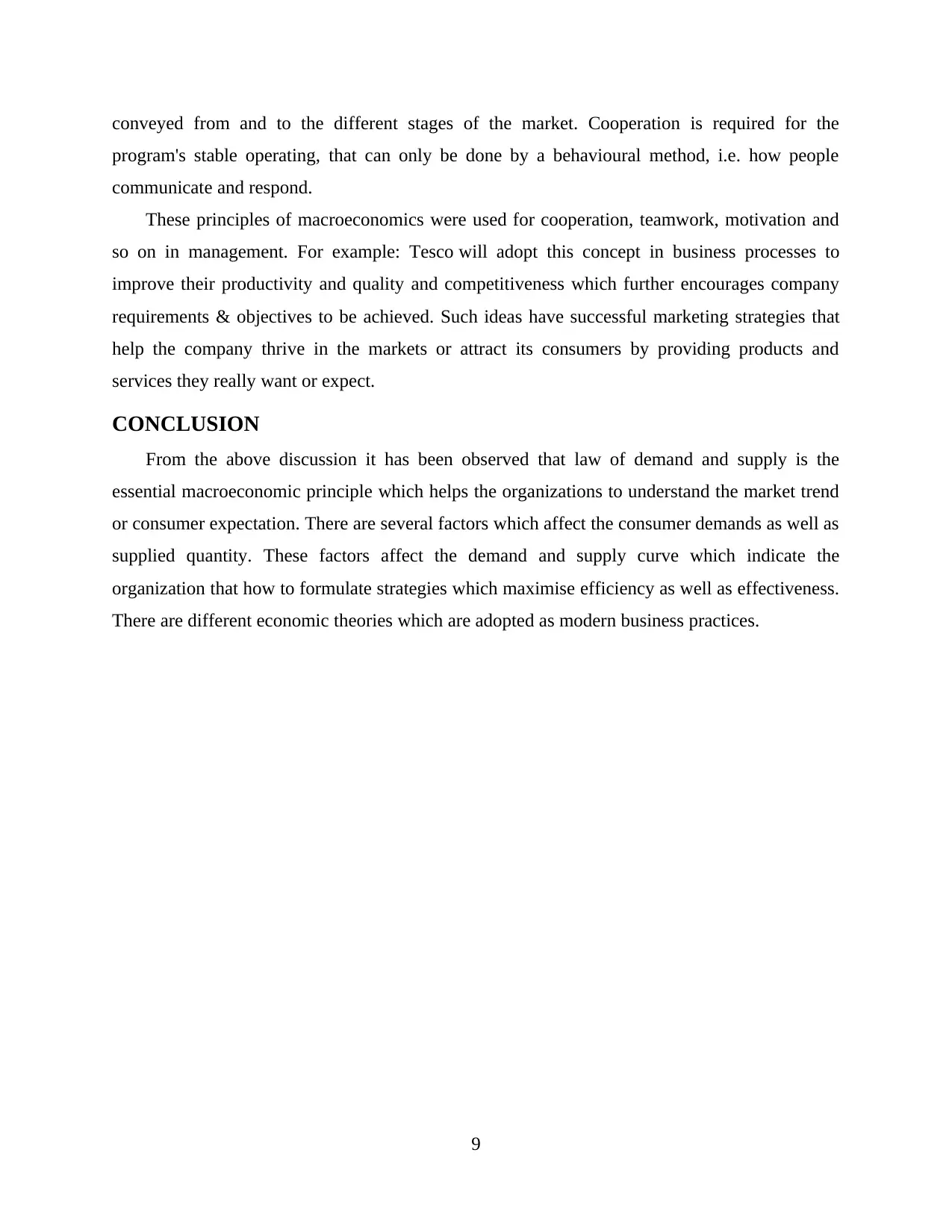
conveyed from and to the different stages of the market. Cooperation is required for the
program's stable operating, that can only be done by a behavioural method, i.e. how people
communicate and respond.
These principles of macroeconomics were used for cooperation, teamwork, motivation and
so on in management. For example: Tesco will adopt this concept in business processes to
improve their productivity and quality and competitiveness which further encourages company
requirements & objectives to be achieved. Such ideas have successful marketing strategies that
help the company thrive in the markets or attract its consumers by providing products and
services they really want or expect.
CONCLUSION
From the above discussion it has been observed that law of demand and supply is the
essential macroeconomic principle which helps the organizations to understand the market trend
or consumer expectation. There are several factors which affect the consumer demands as well as
supplied quantity. These factors affect the demand and supply curve which indicate the
organization that how to formulate strategies which maximise efficiency as well as effectiveness.
There are different economic theories which are adopted as modern business practices.
9
program's stable operating, that can only be done by a behavioural method, i.e. how people
communicate and respond.
These principles of macroeconomics were used for cooperation, teamwork, motivation and
so on in management. For example: Tesco will adopt this concept in business processes to
improve their productivity and quality and competitiveness which further encourages company
requirements & objectives to be achieved. Such ideas have successful marketing strategies that
help the company thrive in the markets or attract its consumers by providing products and
services they really want or expect.
CONCLUSION
From the above discussion it has been observed that law of demand and supply is the
essential macroeconomic principle which helps the organizations to understand the market trend
or consumer expectation. There are several factors which affect the consumer demands as well as
supplied quantity. These factors affect the demand and supply curve which indicate the
organization that how to formulate strategies which maximise efficiency as well as effectiveness.
There are different economic theories which are adopted as modern business practices.
9
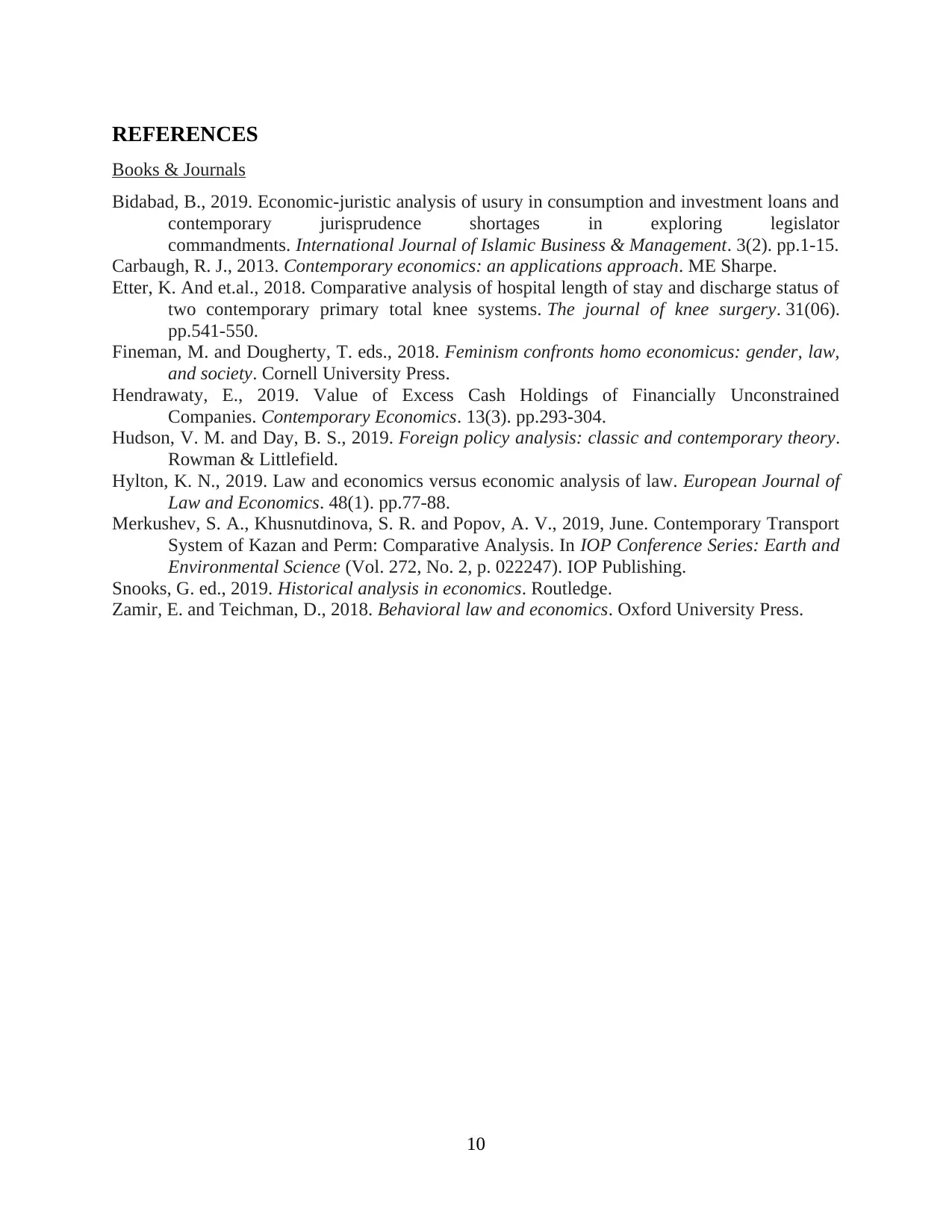
REFERENCES
Books & Journals
Bidabad, B., 2019. Economic-juristic analysis of usury in consumption and investment loans and
contemporary jurisprudence shortages in exploring legislator
commandments. International Journal of Islamic Business & Management. 3(2). pp.1-15.
Carbaugh, R. J., 2013. Contemporary economics: an applications approach. ME Sharpe.
Etter, K. And et.al., 2018. Comparative analysis of hospital length of stay and discharge status of
two contemporary primary total knee systems. The journal of knee surgery. 31(06).
pp.541-550.
Fineman, M. and Dougherty, T. eds., 2018. Feminism confronts homo economicus: gender, law,
and society. Cornell University Press.
Hendrawaty, E., 2019. Value of Excess Cash Holdings of Financially Unconstrained
Companies. Contemporary Economics. 13(3). pp.293-304.
Hudson, V. M. and Day, B. S., 2019. Foreign policy analysis: classic and contemporary theory.
Rowman & Littlefield.
Hylton, K. N., 2019. Law and economics versus economic analysis of law. European Journal of
Law and Economics. 48(1). pp.77-88.
Merkushev, S. A., Khusnutdinova, S. R. and Popov, A. V., 2019, June. Contemporary Transport
System of Kazan and Perm: Comparative Analysis. In IOP Conference Series: Earth and
Environmental Science (Vol. 272, No. 2, p. 022247). IOP Publishing.
Snooks, G. ed., 2019. Historical analysis in economics. Routledge.
Zamir, E. and Teichman, D., 2018. Behavioral law and economics. Oxford University Press.
10
Books & Journals
Bidabad, B., 2019. Economic-juristic analysis of usury in consumption and investment loans and
contemporary jurisprudence shortages in exploring legislator
commandments. International Journal of Islamic Business & Management. 3(2). pp.1-15.
Carbaugh, R. J., 2013. Contemporary economics: an applications approach. ME Sharpe.
Etter, K. And et.al., 2018. Comparative analysis of hospital length of stay and discharge status of
two contemporary primary total knee systems. The journal of knee surgery. 31(06).
pp.541-550.
Fineman, M. and Dougherty, T. eds., 2018. Feminism confronts homo economicus: gender, law,
and society. Cornell University Press.
Hendrawaty, E., 2019. Value of Excess Cash Holdings of Financially Unconstrained
Companies. Contemporary Economics. 13(3). pp.293-304.
Hudson, V. M. and Day, B. S., 2019. Foreign policy analysis: classic and contemporary theory.
Rowman & Littlefield.
Hylton, K. N., 2019. Law and economics versus economic analysis of law. European Journal of
Law and Economics. 48(1). pp.77-88.
Merkushev, S. A., Khusnutdinova, S. R. and Popov, A. V., 2019, June. Contemporary Transport
System of Kazan and Perm: Comparative Analysis. In IOP Conference Series: Earth and
Environmental Science (Vol. 272, No. 2, p. 022247). IOP Publishing.
Snooks, G. ed., 2019. Historical analysis in economics. Routledge.
Zamir, E. and Teichman, D., 2018. Behavioral law and economics. Oxford University Press.
10
⊘ This is a preview!⊘
Do you want full access?
Subscribe today to unlock all pages.

Trusted by 1+ million students worldwide
1 out of 12
Related Documents
Your All-in-One AI-Powered Toolkit for Academic Success.
+13062052269
info@desklib.com
Available 24*7 on WhatsApp / Email
![[object Object]](/_next/static/media/star-bottom.7253800d.svg)
Unlock your academic potential
Copyright © 2020–2025 A2Z Services. All Rights Reserved. Developed and managed by ZUCOL.


